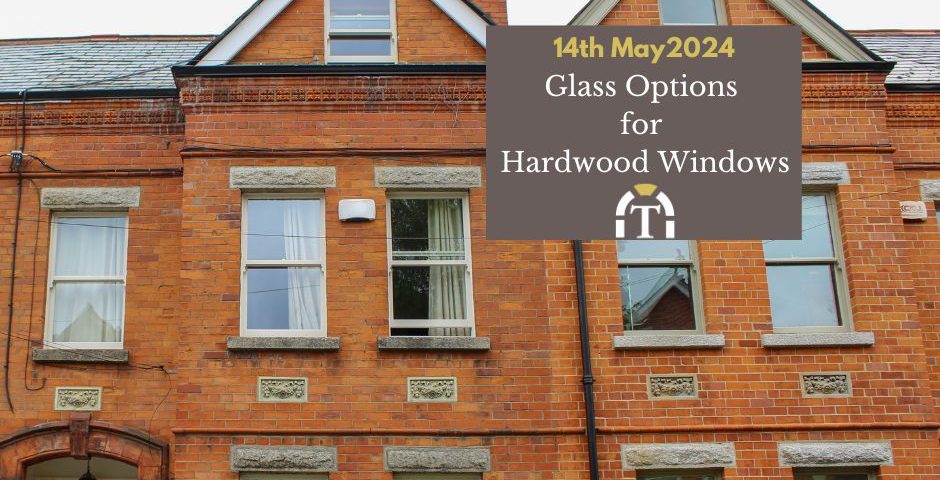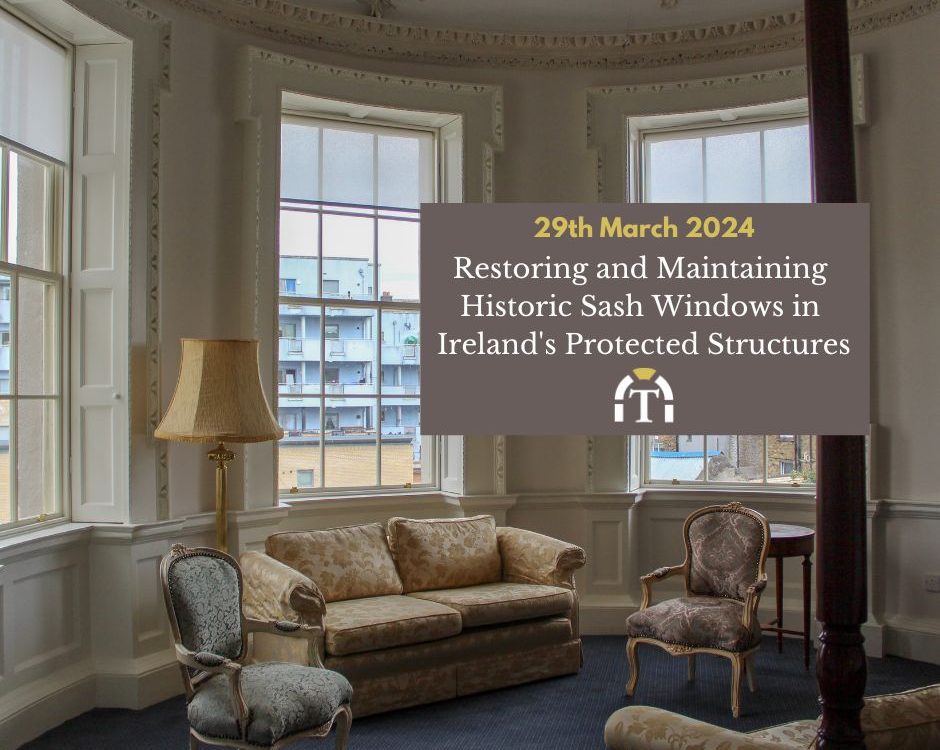
Tree Planting & Sustainability
07/05/2024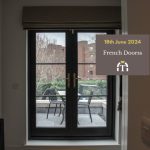
French Doors Ireland
19/06/2024There are a range of glass option for hardwood sash windows and it is useful to know how they can enhance performance and preserve heritage.
Hardwood sash windows are beautiful and timeless features of traditional Irish buildings, adding a touch of elegance and character. They not only enhance the aesthetic appeal of a property but also provide functional benefits such as natural light, ventilation, and insulation. When it comes to selecting the right glass options for hardwood sash windows in Ireland, homeowners need to consider various factors, including energy efficiency, acoustic insulation, and the preservation of heritage. Furthermore, it is important to be aware of these choices with regard to building regulations.
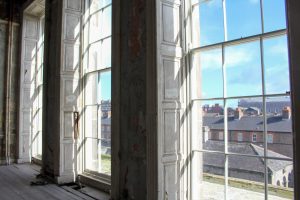
Original single glazing
Conservation windows, or windows in protected structures and ACA’s (architectural conservation areas) are protected under the Planning & Development Act Part IV, 2000. This means that any alteration to the windows (including the glass) will require planning permission. You can seek the advice of your local authority conservation officer. Windows that have original glass must generally retain that glass.
In the case of window restoration, at our joinery we carefully remove the original glass and restore/maintain the timber sections as necessary before returning the glass to the window. This single glazing is often mouth blown crown or cylinder glass which could be over 250 years old, hence the importance of preservation. It is often tinged with different colours due to the silica substrate used in the manufacture. You can also see seeds and waviness in the glass from the process of making it.
Single glazing holds significant historic and architectural value, contributing to the overall character of the building. However, it is essential to ensure that the single glazing is well-maintained and it can be supplemented with other measures, such as secondary glazing (see below), or using shutters and curtains, to improve energy efficiency and thermal comfort. These features are a wonderful part of our architectural heritage and a nod to the original craftspeople who worked pre-electricity and using their hands and simple tools to make these windows.
“The difference between a cold clinical light seen through modern float glass and a warm refracted light through early Victorian cylinder glass is profound.” – BuildingConservation.com
Slimline Double Glazing
Slimline double glazing combines the benefits of energy efficiency and improved thermal insulation without compromising the original appearance of the sash windows. This type of glass consists of two thin panes with a narrow cavity in between, providing insulation while maintaining the slim sightlines of traditional glazing. Typically they are 4/4/4 with an krypton gas fill. You can choose to have a white or black spacer.
4/4/4 and 4/8/4 Glass
The 4/4/4 and 4/8/4 glass configurations are commonly used in hardwood sash windows in Ireland. These configurations refer to the number and thickness of glass panes in the window unit. The first number represents the exterior pane, the middle number denotes the cavity, and the last number represents the interior pane. These configurations provide improved thermal performance and sound insulation compared to single glazing, while still maintaining the traditional appearance. The U-values vary according to the thickness of the cavity.
Vacuum Fineo Glass
Fineo vacuum glazing is an innovative technology that offers exceptional thermal performance and sound insulation for windows. It consists of two glass panes separated by a micro-thin vacuum, creating an ultra-low conductive environment. This vacuum space eliminates heat transfer and significantly reduces the U-value, making Fineo vacuum glazing highly energy-efficient. Additionally, the vacuum layer acts as a barrier to sound transmission, providing excellent acoustic insulation. Similar to the slimglazing above, it is suitable for retrofitting into old windows, although due to technical reasons, we recommend using a single pane per sash. In the case of multi-paned sash windows we would then apply glazing bars to the surface.
Acoustic Laminates
In urban areas or properties near busy roads, acoustic laminates are an excellent option for hardwood sash windows. These laminated glass panes consist of multiple layers with an interlayer that provides noise reduction properties. Acoustic laminates can significantly reduce external noise, creating a quieter and more peaceful indoor environment.
U-Values
U-values measure the rate of heat loss through a material. When selecting glass options for hardwood sash windows in Ireland, it is important to consider low U-values. Lower U-values indicate better thermal insulation and energy efficiency. Slimglazing and multiple-pane configurations, such as 4/4/4 and 4/8/4, offer improved U-values compared to single glazing.
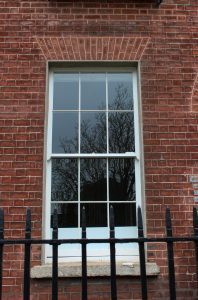
Building Regulations for Traditional Buildings
Part L of Building Regulations
Part L of the Building Regulations sets out requirements for energy efficiency in buildings. When replacing or upgrading windows, it is essential to choose glass options that meet the minimum energy efficiency standards. According to the building regulations 2022 part L, new windows in dwellings should achieve a U-value of 1.6 or less. This also applies to replacement windows, doors and rooflights in existing buildings.
Protected Structures and Conservation Areas
If your building is listed or located within a conservation area, it is exempt from complying with these building regulations. Instead you should follow best conservation practise: “Do as much as necessary and as little as possible”… “Conserve and repair” … “Minimum intervention”.
Traditional Buildings
Nearly all buildings constructed in Ireland from medieval times up until 1940 were constructed using traditional methods. In the Government’s Advice series, traditional buildings in Ireland primarily consists of those built with solid masonry walls of brick or stone, often originally finished with a lime-based render, single-glazed timber or metal windows, and a timber-framed roof clad in slate, tiles, copper or lead. In the case of traditional, permeable buildings, these buildong regulations state that the best insulation standards that are compatible with maintaining the character should be used.
The aim instead should be to improve the energy efficiency as far as is reasonably practicable. The work should not prejudice the character of the building or increase the risk of long-term deterioration of the building fabric. Ultimately, it can be damaging to have a requirement for the buildings to improve above their technical capabilities. For example, replacing single glazing with glazing that has an extremely low U-value, may cause the window to have a lower value than the fabric of the building which will cause the moisture to move into the walls and become trapped, especially if impermeable paint and plaster are used. The Government recently published a new Advice series to this effect. This booklet is specifically for traditional buildings and how to improve their energy efficiency.
Secondary Glazing
Secondary glazing involves installing an additional pane of glass in a frame on the interior side of the existing window. It provides an extra layer of insulation, reduces noise transmission, and enhances energy efficiency. Secondary glazing is a reversible solution, making it particularly suitable for protected structures where the original fabric remains unaltered. This is increasingly popular in Ireland. It is a bespoke solution that will depend on the measurements of your windows and is decided on a case-by-case basis. To find out more, read our post on secondary glazing here.
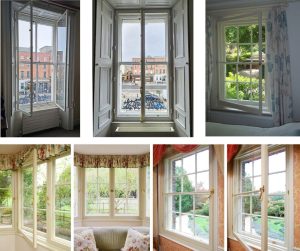
Choosing the right glass options for hardwood sash windows in Ireland requires a careful balance between performance and heritage preservation. It is important ta balance between authenticity and modern performance. Additionally, adherence to building regulations, especially regarding energy efficiency, is essential for the long-term sustainability of traditional buildings. By understanding the available glass options and regulatory requirements, homeowners can make informed decisions to enhance the beauty and functionality of their hardwood sash windows while preserving the unique character of their traditional buildings.


